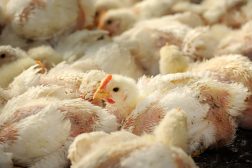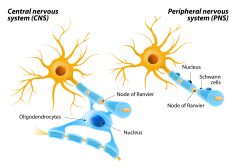Table of Contents
Definition
noun
plural: transfer ribonucleic acids
trans•fer ri•bo•nu•cle•ic ac•id, ˈtɹænsfɝ raɪboʊnjuːkliːɪk ˈæsɪd
A ribonucleic acid RNA involved in protein synthesis, particularly transporting specific amino acid to the ribosome to be added onto the growing polypeptide chain
Details
Overview
Ribonucleic acid (RNA) is a nucleic acid, which similar to deoxyribonucleic acid (DNA) is made up of linear chains of monomeric nucleotides. Each nucleotide component, in turn, is made up of phosphoric acid, sugar, and nitrogenous base. RNA differs from DNA in being generally single-stranded and with a ribose sugar component as opposed to DNA’s deoxyribose sugar. Another marked difference is the uracil of RNA in place of thymine in DNA. Thus, adenine complementary base pairs with uracil in RNAs. One of the main functions of RNA is for protein synthesis. There are three major types of RNA involved in this process: (1) messenger RNA (mRNA), (2) transfer RNA (tRNA), and (3) ribosomal RNA (rRNA). During protein synthesis, transfer RNA transports specific amino acid to the ribosome to be added onto the growing polypeptide chain.
Structure
Transfer ribonucleic acid (tRNA) is comprised typically of 76 to 90 nucleotides. Its molecular weight is about 25,000 to 30,000 Daltons. Apart from the usual nucleotides such as adenine, cytosine, guanine, and uracil, it may also contain unusual nucleotides such as pseudouracil, inosine, and dihydroxyuridine”.
The primary structure of tRNA is a molecule that is comprised of particular sequence of nucleotides. It occurs as a succession of nucleotides in precise order presented in 5′ end to the 3′ end. The secondary structure of tRNA is its cloverleaf structure, a 2D configuration formed from hydrogen bonds. The tertiary structure of tRNA is the L-shaped 3D structure formed from coaxial stacking of the helices. Hydrogen bonds occur between certain nitrogenous bases, between nitrogenous bases and ribose-phosphate backbone, and between ribose-phosphate backbones. The 3D structure of tRNA is comprised of the following:
| tRNA components | Features | Function |
| 5′ terminal phosphate group | The phosphate group attached to the 5′-terminal, i.e. at the C5 of ribose at its terminus | The presence of 5′-phosphate group allows the ligation of two nucleotides |
| Acceptor stem | It refers to the base pairing between the nucleotides (about seven to nine base pairs) of the 5′-terminal and of the 3′-terminal. It also includes the CCA tail, which simply refers to the cytosine-cytosine-adenine sequence at the 3′-end. This is where the amino acid docks. The –COOH of the amino acid covalently attaches to the 3′-OH of the adenine in the CCA tail (forming amino acyl tRNA). | It serves as the site of attachment (esterification) of amino acids to tRNA, particularly covalently bonding with the 3′-OH group on the CCA tail. The CCA tail is also essential for enzymes to recognize tRNA. For instance, ribonuclease P (the enzyme that removes extra nucleotides from 5′-terminal) recognizes the CCA sequence (as well as the nucleotides within the TY loop) of the tRNA.1 |
| Variable loop | The part of the tRNA between the anticodon loop and TΨU, and consists of nucleotides between 3 and 21, which depends on the amino acid that the tRNA encodes | When present, it provides stability to the tRNA. It may also be used during the recognition of the aminoacyl tRNA synthetase for tRNA. The presence of variable loop may be used to classify tRNAs into class 1 (lacking variable loop) and class 2” (variable loop, present). |
| D arm | It is the part of the tRNA comprised of stem and loop, where the stem contains about four to six base pairs, and then, it ends in a loop that often contains dihydrouridine | It helps stabilize tRNA structure and serves as a recognition site for specific enzyme aminoacyl-tRNA synthetase. |
| Anticodon arm | It is a part of the tRNA comprised of stem and loop, where the stem contains five base pairs whereas the loop contains seven unpaired nucleotides. Of these seven, the middle three serves as the anticodon. | The anticodon in the loop recognizes and eventually binds with the codon of the messenger RNA. |
| T arm | It is a part of the tRNA comprised of stem and loop, where the stem contains five base pairs whereas the loop contains seven unpaired base pairs. Of the seven base pairs in the loop, three of them are TΨC (i.e. thymine, psuedouridine, and cytosine) | The loop contains the ribosome recognition site |
Biological function
tRNA is a ribonucleic acid that picks up the specific amino acid from the cytoplasm and then transports it to the ribosome to be added onto the growing chain of amino acid. In essence, it has two major regions important in protein synthesis, i.e. one that connects with the codon of the mRNA via tRNA anticodon and the other that serves as attachment site for specific amino acid.
Common biological reactions
Common biological reactions
In prokaryotes, tRNAs are synthesized in the cytoplasm whereas in eukaryotes, they are synthesized inside the nucleus. RNA polymerase III facilitates the transcription of pre-tRNAs as encoded by the tRNA genes. Transcription is brought into a halt when there are four or more thymidines. The pre-tRNAs will then undergo maturation. They become mature functional tRNAs by RNA folding and trimming (i.e. removing the introns through tRNA-splicing endonucleases). In bacteria, introns are removed via self-splicing. After trimming, the enzyme multifunctional tRNA ligase joins the spliced tRNAs back. Prior to transport to the cytoplasm, tRNAs are aminoacylated. Los1/Xpo-t facilitates the transport of mature tRNAs into the cytoplasm.
Common biological reactions
Protein synthesis is comprised of two processes, i.e. transcription and translation. Transcription is the process in which messenger RNA (mRNA) is produced based on a DNA template. The mRNA moves from the nucleus to the cytoplasm to reach the site of protein synthesis, the ribosomes. In the ribosome, translation occurs. It is when the amino acids transported by the tRNAs will be joined together in a particular order as specified by the genetic code as copied by the mRNA from a DNA segment.
The ribosome is a cytoplasmic structure that serves as the site of protein synthesis. It has three binding sites: A, P, and E sites. The A site binds to aminoacyl-tRNA (a tRNA with an amino acid). The P site is the site in a ribosome occupied by tRNA carrying the growing peptide chain (i.e. peptidyl tRNA). The E site is the site for decylated tRNA on transit out from the ribosome.2 Using messenger RNA as a template, the ribosome traverses each codon and pair it with a specific amino acid attached to a transfer RNA.
Supplementary
Abbreviation(s)
- transfer RNA
- tRNA
Synonym(s)
Derived term(s)
- Cysteinyl-trna synthetase
- Glycine-trna ligase
- Initiation trna
- Queuine trna-ribosyltransferase
- Starter trna
- Suppressor trna
- Valine-trna ligase
Further reading
See also
Reference
- Acceptor Stem (Molecular Biology). (2019). Retrieved March 20, 2019, from ://what-when-how.com/molecular-biology/acceptor-stem-molecular-biology/ Link
- A-site, P-site and E-site. Retrieved from ://www.nobelprize.org/educational/medicine/dna/a/translation/epa.html Link
© Biology Online. Content provided and moderated by Biology Online Editors







